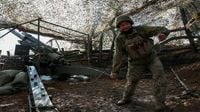On October 29 and 30, 2025, a new chapter in the war of narratives between Russia and Ukraine played out against the backdrop of fierce fighting in the eastern regions of Donetsk and Kharkiv. Russian President Vladimir Putin, speaking from the Central Military Clinical Hospital in Moscow, made a dramatic claim: Russian troops had successfully surrounded Ukrainian forces in two key cities—Pokrovsk and Kupyansk—and he was offering a temporary halt in hostilities so journalists, including those from Ukraine and the West, could visit the front lines to see the situation for themselves.
But Kyiv’s response was swift, unequivocal, and deeply skeptical. Ukrainian officials, drawing on painful memories of past Russian promises, warned journalists not to trust the Kremlin’s invitation and to steer clear of any so-called “safe corridors” into the combat zone. The Ukrainian Ministry of Foreign Affairs, through spokesperson Heorhii Tykhyi, issued a pointed reminder: “Frankly, I do not recommend that any reporters trust any of Putin’s proposals for ‘corridors’ in the warzone,” Tykhyi wrote, referencing the infamous 2014 Ilovaisk tragedy, where a supposed Russian ceasefire led to a massacre of Ukrainian troops as they tried to withdraw.
The Russian offer—announced with fanfare by the Ministry of Defense—proposed a 5-6 hour pause in fighting in Pokrovsk, Myrnograd, and Kupyansk. Journalists, Putin claimed, would be transported to specific locations to “see what is happening, talk to Ukrainian servicemen, and leave.” Russian officials presented this as an opportunity to verify Moscow’s assertion that Ukrainian forces were encircled and on the brink of surrender, a narrative intended to pressure Kyiv and its Western backers.
Yet, as reported by Kyiv Post and other outlets, Ukrainian military officials immediately dismissed the Russian claims as “fabrications and fantasies.” A spokesperson for Ukraine’s eastern forces acknowledged that the situation in Pokrovsk was “hard,” but insisted it remained “under control.” Meanwhile, Commander-in-Chief Oleksandr Syrsky flatly labeled the encirclement allegations as fake, underscoring Ukraine’s determination not to cede ground in the information war.
There’s good reason for Ukrainian caution. As Tykhyi reminded the world, “Putin’s only goal is to prolong the war. And he has never kept any of his ceasefire pledges. Do not assist him in justifying his crimes through Russian provocations against journalists.” The memory of Ilovaisk, where hundreds of Ukrainian soldiers died after trusting a Russian promise of safe passage, looms large in the Ukrainian psyche. Tykhyi, who witnessed the 2014 tragedy firsthand while filming a documentary, pointedly warned that accepting the Kremlin’s invitation could have “long-term reputational and legal consequences” for media outlets, as unauthorized visits to Russian-occupied territory violate both Ukrainian law and international law.
The front lines themselves remain as murky as ever. Reports from Ukrainian military sources and independent observers paint a picture of intense, shifting combat. The Ukrainian military said that approximately 11,000 Russian troops were concentrated around Pokrovsk in an attempt to surround the city, with Russian infantry entering the southern districts and triggering street battles. The independent military watch group DeepState confirmed Russian control of the southern parts of Pokrovsk, while Ukrainian forces continued to hold out in the central and northern sectors. “The situation in Pokrovsk is on the verge of critical and continues to deteriorate to the point that it may be too late to fix everything,” DeepState warned.
Meanwhile, the Institute for the Study of War (ISW), a respected Washington-based think tank, offered a more measured assessment. In its October 29 and 30 reports, ISW stated that while Russian forces had advanced near Pokrovsk and had infiltrated some areas, they “almost certainly do not currently control any positions within the city itself.” Regarding Kupyansk, the ISW found no evidence to support Russian claims of an encirclement. The think tank also suggested that Putin’s offer of a temporary ceasefire for journalists was likely a “staged media opportunity” designed to bolster Moscow’s narrative of progress and to demonstrate Russian openness to a ceasefire—particularly as Russia has publicly rejected U.S. President Donald Trump’s proposed ceasefire along the current frontlines.
On the ground, the fighting remains brutal and unpredictable. Small-scale engagements, including house-to-house battles and relentless drone and artillery fire, have become the norm in both Pokrovsk and Kupyansk. Ukrainian officials maintain that, despite the pressure and the presence of thousands of Russian troops, their defenses are holding. Yet, the fog of war makes independent verification of the shifting battle lines all but impossible. Western journalists, for all the Kremlin’s talk of transparency, would be shepherded only to “specific locations” under Russian control—hardly a recipe for impartial reporting.
The broader context is impossible to ignore. Nearly four years into Russia’s invasion, Moscow is seeking to leverage its advantages in manpower and weaponry to force a shift in momentum, both on the battlefield and in the court of public opinion. By inviting journalists to witness a purported Ukrainian collapse, Putin aims to sow doubt about the efficacy of continued Western support for Kyiv and to paint Russia as the inevitable victor. Ukrainian officials, for their part, remain deeply wary of any Russian overtures, having learned from bitter experience that Kremlin promises are rarely what they seem.
For journalists, the dilemma is stark. Accepting Putin’s invitation risks lending legitimacy to a propaganda exercise and potentially violating Ukrainian and international law. Declining the offer, on the other hand, means relying on secondhand reports and military statements in a conflict where both sides are keenly aware of the power of perception. As Heorhii Tykhyi put it, “We are watching closely.”
In the end, the battle for Pokrovsk and Kupyansk is being fought not just with artillery and drones, but with words and images. With so much at stake, the truth remains as contested as the territory itself, and the world is left to parse claims and counterclaims in the shadow of war.
